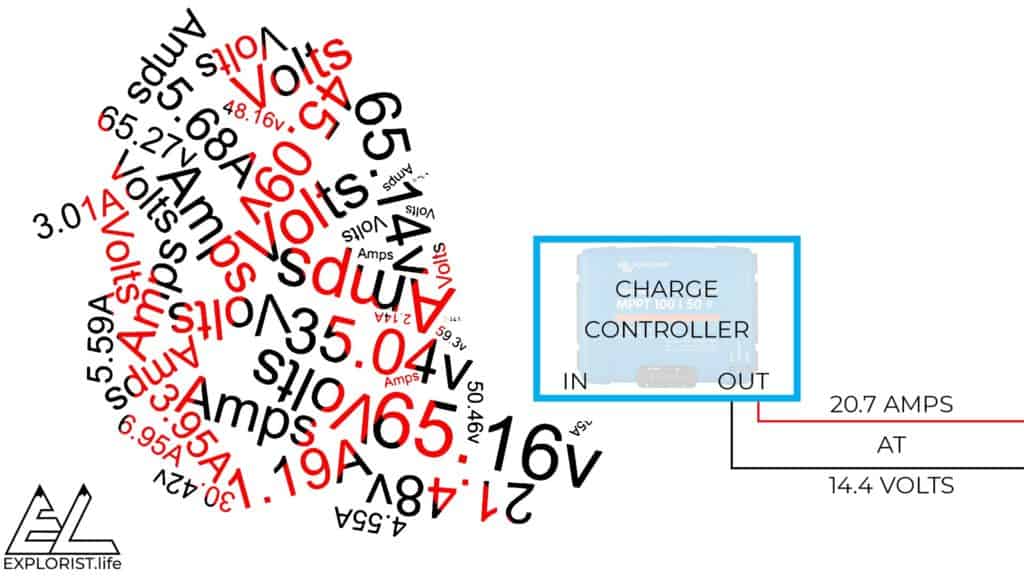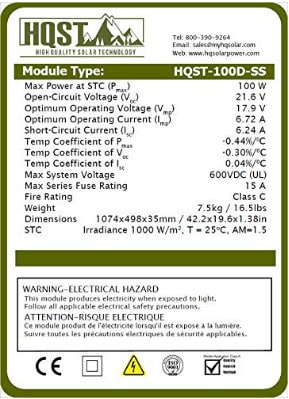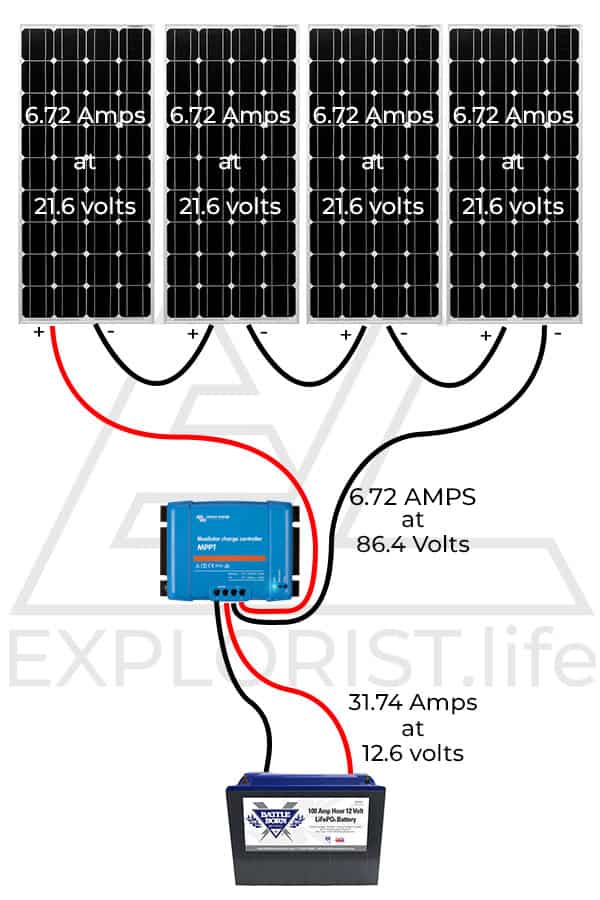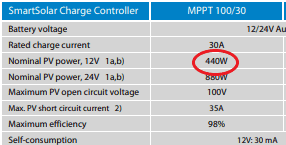What is a Solar Charge Controller?
The Charge Controller takes the power made by the solar panels and
Also, we have interactive solar wiring diagrams that are
Finally, for this blog post you’re reading right now, we have a calculator that will help you choose a charge controller. I HIGHLY recommend reading this post to truly learn how a charge controller works, but if all you need is the calculator, here that is:
How does the Charge Controller Work?
Solar panels typically put out a voltage that is too high for batteries to use. If you have your solar panels wired in series

MPPT vs PWM CHARGE CONTROLLERS
There are two main types of charge controllers. They are MPPT and PWM. This blog post is a crash course in solar design and getting into the specifics of the differences is out of the scope of this blog post. Here’s what you need to know regarding MPPT vs PWM charge controllers MPPT is the newer, more efficient technology. From here on out, any time I talk about charge controllers, I will only be talking about MPPT charge controllers as I want to guide you to build a high-end, expandable solar setup.
HOW TO MATCH SOLAR PANELS TO A CHARGE CONTROLLER
One of my favorite series of charge controllers is the Victron BlueSolar MPPT Charge Controller. If you’ll notice, there are MANY different sizes of charge controllers:
- Victron SmartSolar MPPT 75 | 10
- Victron SmartSolar MPPT 75 | 15
- Victron SmartSolar MPPT 100 | 15
- Victron SmartSolar MPPT 100 | 20
- Victron SmartSolar MPPT 100 | 30
- Victron SmartSolar MPPT 100 | 50
- Victron SmartSolar MPPT 150 | 35
- Victron SmartSolar MPPT 150 | 45
- Victron SmartSolar MPPT 150 | 60
- Victron SmartSolar MPPT 150 | 70
- Victron SmartSolar MPPT 150 | 85
- Victron SmartSolar MPPT 150 | 100
- Victron SmartSolar MPPT 250 | 85
- Victron SmartSolar MPPT 250 | 100
WHAT DO THOSE NUMBERS MEAN?!?
*MATH ALERT*
Let’s say, for example, you have 4 x

EACH 100w solar panel has an Open-Circuit Voltage (Voc) of 21.6 volts. and an Optimum Operating Current of 6.72 Amps. Those are the only two numbers we are concerned about for now. I generally recommend just wiring all of your solar panels in series for simplicity and efficiency sake. Which means: Those 4 x 100 watt solar panels get wired together like this:

Since they are wired in series, the voltages get ADDED together for a total of 86.4 volts. (Open-Circuit Voltage (Voc) of 21.6 x 4 panels) The amps on the “upstream” side of the 100w solar panels
So, the 86.4 volts is under the safe threshold of the 100 max volts of the Victron SmartSolar MPPT 100 | 30 solar controller.
100 is the first number. What about the 2nd number, 30?
The 30 in the Victron SmartSolar MPPT 100 | 30 is the MAX resulting amps AFTER the solar controller has worked
- We have 4×100 watts of solar panels totaling 400 watts of solar.
- Assume batteries are 12.6v
- Amps = Watts / Volts
This means, that at 400 watts and 12.6v we can expect up to 31.74 amps coming out of the solar controller.

400 watts / 12.6 volts (Battery) = 31.74 amps coming out of the charge controller.
Now, we are talking about that Victron SmartSolar MPPT 100 | 30, we have to compare that 2nd number, 30.
31.74 amps is a bit over the 30 amp threshold. BUT…
Solar panels rarely put out their full wattage. AND…
In the Victron SmartSolar MPPT 100 | 30 manual, they say their controller is good for solar arrays up to 440 watts:

AND… If you happen to go ‘over’ on your Amperage, it’s not that big of a deal in terms of damage. It’ll just be lost power that the controller won’t convert.
So, basically, the Victron SmartSolar MPPT 100 | 30 is pretty perfect for those 4 x 100 solar panels.
But what if you like playing it safe? What if you want some wiggle room? Great! Size up to the Victron SmartSolar MPPT 100 | 50. Sure, it’s a little more money, but if it’s worth your
Now, Why would you want wiggle room or safety margin? Let’s talk about temperature
Solar Controller vs Temperature
DID YOU KNOW… As temperatures drop, solar panels actually put out MORE power.
Totally honest though, the math gets messy, SO I made a calculator that you can input all of the values for your setup so YOU can see how temperature affects your solar panel setup AS WELL AS will give you a recommendation on what solar controller you need taking solar panel temperature into account.
There’s a video below the calculator you can check out if you need additional instructions on how to use it:

Now that you know what kind of charge controller is compatible with your solar panels, it’s time to learn how to choose an inverter for your DIY Camper setup. Check that out here:
https://www.explorist.life/how-to-choose-an-inverter-for-your-diy-camper/
Everything that you are learning here is put to use in our FREE Interactive Solar Wiring Diagrams. If you haven’t yet, check them out as they are a complete solution for a camper van electrical system. Check them out here: https://www.explorist.life/solarwiringdiagrams/
Remember, this is just one part of a full camper van electrical educational series. To see all of the individual guides, click here: https://www.explorist.life/diy-campervan-solar
Finally, If you found this guide helpful, It’d truly mean the world to us if you’d share it with somebody who can use it, pin it to pinterest for later reference, or share it to a facebook group when somebody has a question about this subject. Click the bubble in the lower right corner to subscribe to be notified of future updates and as always, leave any questions you’ve got in the comments below.



71 Responses
Hi Nate,
Thanks for the great info, I am learning a lot!
We want to add 1 extra 100 watt panel to our caravan. Renogy.
It currently has 5 x 100 watt solar panels. So the full array would be 600 watts in parallel.
It currently has a Victron Smartsolar 100/30 solar controller.
Would the Victron Smartsolar 100/50 be the suitable controller to upgrade to?
Thank you for your advice,
Sally
5 panels wired in series would push you over the max voltage rating of the 100/50. The wattage of the array is fine, but the voltage is too high. You’d want to upgrade to the 150/60: https://amzn.to/3wqPEyx
Hi Nate, thank you for the excellent tutorials! They are a HUGE help.
Regarding charge controllers – when wiring in multiple panels, what are the pros/cons of using one larger controller for all of the panels vs. breaking up the panels up into smaller arrays with multiple smaller chargers? Is there a cost/benefit for one setup vs the other? Other than a basic dollar or space savings?
Looking at the system I’m designing, it seems as though using two smaller controllers would be significantly cheaper than trying to wire the entire array into one large controller but I wanted to make sure there wasn’t anything I’m missing.
Thanks!
There’s rarely anything wrong with using mutliple charge controllers given each array is properly configured. From a cost standpoint… if it causes you to need to use a 2nd Lynx Distributor due to neededing extra spaces, that may be a deterrent. Be sure to budget wire, lugs, fuses, heat shrink, etc because all of that stuff adds up too.
Hi Nate, Thank you for all the information provided. It is a great source.
I am considering using 3 x 400W solar panels for my build with a 600 Ah battery set. Using your calculator, I get 163V and 106 Amps for the total array. Would the Victron 150/100 VE.Can work for this? What would be your recommendation?
Thank you.
163V into a 150V charge controller like the 150/100 would damage it. You’d want the next higher size, which would be the SmartSolar MPPT 250/100: https://battlebornbatteries.com/product/victron-smartsolar-mppt-250-100/?afmc=explorist_bb67
@Nate Yarbrough, Thank you very much. Much appreciated.
Hey Nate! My wife and I are JUST getting in to the weeds of the solar system of our new van (first time builders), and up to this point have been purchasing all of our electrical components from Renogy, however after watching and reading all of your walkthroughs, along with some others, are debating if we’d made a mistake by not going with Victron. So my question, is if we already have Renogy panels, batteries and charge controller, can we use the Victron multi-plus, or do we ultimately need to stay with Renogy at this point? Thanks in advance!
Renogy panels and batteries are 100% fine to use with Victron components. Mixing and matching Victron and Renogy components (inverter/charger, charge controller, & battery monitor) will ‘work’ but they won’t communicate with each other in the VictronConnect app for system monitoring.
Hi, Nate–just watched your YT video on wiring different size or mismatched panels. . .at the 11 minute mark you talked about adding that extra panel that would REDUCE the voltage of the other panels. . . As stated previously I have 5 panels in parallel that are EACH putting out 85 voc–is it possible to add another panel with a 17-22 volt voc and bring the others down to that level so I can use them in a 12 volt battery bank? Thank you!
The voltage would come down, but so would the total array wattage as there would be pretty significant power loss. Just wire your panels in parallel and use a 150V charge controller (https://amzn.to/38E0V2w).
@Nate Yarbrough, I won’t ask anything more after this: I cannot afford $550 for the controller and if I cannot get the voltage down for use with my established 12 volt system the 5 panels will be of no use at all and essentially dead. Last question: how much wattage will be left by adding a 17-22 voc panel? Thank you, Nate, you have greatly added to my knowledge. Scott
To find out how much wattage would be left in the array by adding another lower voltage panel, you can use the formulas taught here: https://www.youtube.com/watch?v=jejro4zkl8I&list=PLmvhcyi4n0TVgcroqXl5QvJM0afUes_zX
I can’t recommend doing what you are proposing though. I’m of the ‘do it right, do it once’ school of thought and adding a 20v panel to multiple 100v panels is not a ‘good workmanship’ way to approach this problem. If money is an issue, I assure you that doing it twice when the first way doesn’t work properly will be way more expensive than just doing it right the first time.
@Nate Yarbrough, thank you, Nate. You are the master!
To further clarify my 12/20 6:39 posting: Each 95 watt panel has a voc of 100 and each one put out about 85 volts yesterday in full sun at about 65 degrees. I am using a 12 volt deep cycle battery bank. Not knowing ANYthing much at the time — I purchased from “a guy” these 5 panels not knowing they were not 12 volt panels. . . WIll the 100/50 controller help me here? Other advice?
If your panels VOC is 100V… that will exceed the max voltage of your 100V charge controller when the temperatures get cold (solar panel voltages increase as temperature decrease.) You’ll likely need a 150V MPPT charge controller and wire all of your panels in parallel.
@Nate Yarbrough, These are in parallel and not series. The tag on the back of each individual panel says 95 watts and 100 voc. I guess this is extremely rare since others have said these specs are not possible. The tag says this per panel and the voltmeter verifies it–per panel. Thank you for your reply, Nate. /Scott
Help! Just discovered my private party purchase of (5) 95 watt 100 voc panels put out 85 volts and I just literally fried a 500 watt 12 volt charge controller. Is there any hope for me to use the high voltage output on a 12 volt battery bank?
To keep the array voltage low, those panels must be wired in parallel. The will also need to be paired with a charge controller that can handle that kind of voltage. I suspect you would need a 150V charge controller, but here’s the specifics on that: https://www.youtube.com/watch?v=MxziHKvTRh8
Also, what makes Victron so much more preferable to Renogy? It is twice the cost, and I’m not sure what the additional benefits are.
The Victron SmartSolar charge controllers allow usage of the VictronConnect app which will show all of the data from the solar array on your phone as well as historical data figures. This is nice because you can see a day-by-day graph of solar production so you can see if your solar array is ACTUALLY performing as it should be and can help troubleshoot problems if there are any. Since it is connected to an app which has internet access, it can receive firmware updates if Victron pushes out new features. For example… soon, Victron will release a firmware update that will allow for COMBINED solar and alternator charging at the same time when a SmartSolar charge controller is used in conjunction with the Orion Smart DC-DC Charger.
Hi Nate! You’re blog has been incredibly useful in learning about solar and general building recommendations. I am purchasing 2 residential panels, which have much higher voltage than the usual RV panels. I’ll have (2) 325W panels in parallel, and in calculating the size MPPT controller I need I am getting conflicting information. Some resources say to take your wattage (650w) divided by the battery system voltage (24V Nissan leaf), which would equal 27a, necessitating a 30a controller. Other sources say to take the short circuit amperage (6.03a) and multiply it by the number of panels in parallel (2), which would equal 12a, necessitating only a 15a controller. What are your thoughts on this? How does that short circuit amperage come into play?
This is best explained in a video. Here is a link: https://www.youtube.com/watch?v=MxziHKvTRh8
hello
theres an error in the calculator, the error is when you change it to 24v, it still says,,,
Max Amps Coming out of Solar Controller
This is the max Amps you can expect to see coming out of your solar controller after the solar controller converts your solar panel voltage to the 14.4ish volts required to charge your batteries when the temperature drops to your estimated low temperature.
it still says 14.4is volts, should be 24 right?
Good catch. I don’t have the descriptions set up to change along with the battery bank voltage.
Hey Nate!
Big fan of your work, it has really been a huge help.
Just realized that the MPPT controller that I bought has a common positive or positive ground.
What does that mean and how would that change how I ground my system? Can I just follow your diagrams but change the ground to the positive busbar or do I have to make more changes? I’m a little fuzzy on grounding as a whole, so this discovery just made it more confusing.
Without looking at your exact setup, it’s tough to tell. I’d recommend returning that unit for a unit with a negative ground.
I’m planning out where in my 1984 VW Westfalia to install my Victron MPPT 100/30 charge controller and Renogy 1000W inverter. Keeping in mind that these need ventilation, can they be installed under the bench seat (18″X18″X4′) without the heat damaging the components? Or do they need to be in open air?
So much great info! Learning a lot! I’m currently planning a 1620w system (wired in series). After using the calculator, I get 225 volts into the controller and 144 amps outgoing. However, it seems that the largest Victron unit is 250/100. Are the potential 44amps in excess an issue? What will the excess implicate in terms of system performance, etc…? Thanks so much!
TM
The Victron smart solar charge controllers will cap the amperage at 100 and the additional 44 would just not be used, but the performance issue is going to be more like: ‘why install all of those panels if they aren’t being used’? For systems over 1200w of solar, I recommend using a 24v battery bank as you’ll be able to wire up to 2400w of solar into a single 100A charge controller.
Also… Having 225v into the charger is fine but I would also consider wiring in a series-parallel configuration to get your volts down closer to 100v if possible. The 250v charge controllers can handle the 225v just fine but WOW is that some high voltage and accidentally touching a live wire would make for a pretty bad day (and you could use one of the less expensive 150v charge controllers).
Sorry… that was a lot. Hopefully I didn’t make things more confusing.
Hey Nate I’ve pretty much come to understand the basics of a solar system except the solar charge controller bit. I’m planning to buy 10 of these https://drive.google.com/file/d/1w6Vn5q51lYKGrgymfdjpQ89Ym6Oi6Evy/view
my plan is to do two arrays of 5 in series and combine them. That’s where I get lost. I tried to use your calculator and got some insane numbers and I think it’s because the Temp coefficient of Voc says it’s -80. But even if I make that number something normal like -.5 I’m still not sure if I’m supposed to calculate the system. Once I combine the two series arrays do they go into one charge controller or two? It seems like two smaller charge controllers might be cheaper than 1 large controller but is that the right way to do it and which Victron controller do I need? Thanks for any help I’m out of my depth on this one.
Hey Nate, thanks for all your guidance! I’ve been looking at all your posts and videos and they’ve been helping me a lot with planning my build! One quick question, your wiring diagrams show the positive wire of the solar charge controller connecting to the battery bank before the master switch. Is there a reason for this? Not being an expert, I would think you’d want it connected to the buss bar after the switch so you could disconnect power easily if any repairs or changes need to be made? Thanks for your help!
This will keep your battery topped off during storage while allowing you to disconnect the loads.
Hi Nate, I downloaded your spreadsheet and it’s not working B11 comes up with a #NAME? error no matter what information I input and your prefilled example is also full of errors. Any suggestion?
Try this one instead: https://www.explorist.life/solar-charge-controller-calculator/
Wow, guys!! I am a fairly smart female. However, calculating which MPPT was baffling. Your spreadsheet while great does not compensate for the different ways PV manufacturers list their stats. So, the jump to it without math came in handy. Kudos!! on this blog and for not assuming everybody knows this junk.
Dear Nate,
Should I always go for the highest voltage panels when it comes to using MPPT controllers? i have to choose between 180w 18v mono panel (36cell) and 200W 23V poly panel (48 cells). I understood that higher voltage panels tolerate low irradiance issue better so that the panels keep on working on cloudy days thanks to its initial higher voltage whereas 18v panels would stop charging. The mono and poly panel cost difference is less than 10 USD. .
Not necessarily. Wiring multiple panels in series will yield the same result. The only time I suggest making sure to buy a higher voltage panel is when somebody wants to run only one-single panel. Typically; mono panels produce more power per square inch than their poly counterparts. So, when roof space is at a premium; mono is the way to go.
Dear Nate,
Thanks for reply. We sell solar systems for Mongolian herders. Our current package is powered by 18v 180W mono panel. After reading your article, I was planning to introduce 2 pcs 100W panels for higher voltage advantage to our customers, but 2 panels was going to be too much burden for their nomadic lifestyle. Then I had this idea of introducing 36V halfcut cell panel with 180W power. It is basically equivalent of 2 panels with 50W. This way I can negate voltage drop effects from hot sun and hazy sky better, right?
Thanks,
Manuel
Hi Nate, thanks for all your hard work.
I am installing 2 x 355w panels on my bus. When I do the calculations like listed on your series vs. parallel post, I get 8.9 Amps at 97.8 Volts pre-charge controller, and 56.3 Amps at 12.6 Volts into the battery.
However, when I plug the numbers into your charge controller wizard, it is saying I’ll only receive 10.95 Amps at 12.6 Volts into the battery. I’ve tried changing out the temperature coefficients with other numbers on the spec sheet(in case I’m just inputting the wrong number) but the Amps don’t fluctuate by more than 1 or 2. Any idea what I could be getting wrong?
That is strange. You should be somewhere in the 60amp ballpark at 12v. Maybe take a screenshot of your inputs and share it here: https://www.facebook.com/groups/DIYCampervanCrew/
Thank Nate for advice. However, I do not see any mixing of non-like panels. I would like to think that 3 x 50W panels in parallel will behave as one 150W. Then this one in series with another 150W. See my point?
Oh, okay; I see… but still… IMO; that’s an incredibly messy way to do things. Your junction box is going to be a rats nest of wires as you’ll have to fuse each of your parallel strings PLUS a master disconnect for those 3 panels then run that in series with yet ANOTHER master disconnect for the whole array. It’s just a messy way to design an array.
I still stand by my statement that the 3×50 panels should go into one MPPT and the 150 panel should go into a 2nd charge controller.
Hi Nate,
I have 3 x 50Watts rigid panels wired in parallel into a cheap old 10A mppt controler , and 1 x 150Watts semiflexible into a PWM 10A controller. Of course the system works but leaves a lot to be desired. It gives me 12 to 14 Amps at noon. If I put them in series it seems the Victron 100/30 could handle them. What sort of benefit am I looking at, and does it matter the sequence of the panels in series?
In the mean time, I read your other article Parallel vs in series and I understand I should have the 3x50W panels in parallel and the output in series with the 150W panel to the 100/30 Victron. This looks reasonable to me. But again, what sort of benefit or increase are we expecting over todays all parallel situation? Does it really matter that the 3x50W are rigid and the 150W semiflexible?
Yeah, same as in the other reply: “I would keep the like panels together and not integrate the non-like panel. So… 3 x 50 watt panels into an MPPT and the 150W panel into a separate charge controller. Mixing panel sizes on one charge controller is truly not ideal.”
I would keep the like panels together and not integrate the non-like panel. So… 3 x 50 watt panels into an MPPT and the 150W panel into a separate charge controller. Mixing panel sizes on one charge controller is truly not ideal.
Nate, I read your blogs and learned a lot. I have a question regarding connecting more than 10 or maybe 20 panels. I saw many houses have a lot of panels on their roof. If they are in serious, the voltage would be over 250 or more, while the max voltage in the controllers is 250…if the panels are in parallel, the Amps can be easily go over 30amps….what kinds of wires can take 30amps?? I think most mc4 are 8 or 10amps.
In something like that, lets pretend you wanted to have 25 panels… (This is incredibly generalized and theoretical, btw…) You’d wire 5 panels in series. You’d do that 5 times so you’d have 5 sets of 5 panels wired in series. Those 5 series strings would then get wired in parallel and wired to the charge controller. MC4 connectors would be used up until the point at where everything gets wired in parallel. From then on would be lugs, crimps, screw terminals, or whatever other method the particular install calls for.
Hi Nate, thank you so much for your reply. I just checked out your wiring pages and it has answered all my questions!!! You rock!!
Hey Nate,
I’m trying to decide if there is an advatage to 2x300w panels 18v, 16.66a. Would it produce much more power than your above example? And what size controller would i need. Im so confused. Cheers 🙂
I’m not sure what you’re asking in the first question, but on the page explorist.life/solarwiringdiagrams I have a full setup featuring 2 x 300 watt panels that may help you out.
Also, the ampacity of a 10 gauge wire is 30A if I am reading correctly so isn’t using a 30 amp breaker on a 10 gauge wire the Same as not even having a breaker?
Ok I reread the article and I think I found my mistake. Wiring panels in series gives me 8.6 A according to the info on the panel but if I do the watt conversion I get 320 watts divided by 12.6 which is 25.4 Amps. I just forgot this step because I thought in series I would only get the 8.6 amps listed on one panel since we aren’t adding the amps. I guess the charge Controller does something to bump up the amps! I really don’t understand this part but I’ll go with it if you say it’s correct.
Ok if I run the Blue Sea Circuit Wizard I should use the original 8.6 amps of the batteries in series because the wire is before the charge controller and I get 10 gauge which seems correct.
Hey Nate,
Very informative thanks.
I have two panels of 160 each for total of 320 watts. The optimum voltage of 22.8 volts and 8.6 amps. So In series I get 45.6 volts and a measly 7.01 amps. Shouldn’t I wire them in parallel to increase the amps? I have two 6v agm’s in series and a blue sea MPPT 100/50 charge controller for future upgrade.
Hi There,
I am setting up a 300 watt system – (3) 100 Watt panels but I was going to set them up in parallel. Can you tell me what the benefit would be to hook them up in series? I am looking at a 30 amp charge controller, will that be big enough?
Hey Jim! Here is a blog post that talks about series vs parallel: https://www.explorist.life/solar-panels-series-vs-parallel/
For that setup, you’d be looking for the Victron SmartSolar MPPT 150 | 35
Hey – thanks for all the great info! I have a query regarding the Aims Power 30A Charge Controller listed in your shop. Right under the heading it states ” make sure this fits by entering your model number.” What do you mean? Thanks again!
That is just information that is auto-pulled from the Amazon listing. Just ignore it until I get around to deleting that part. 🙂
hello thanks for the info mate xan you link me to the calculator that works how much power im using and what solar panels and batteries i would need please
Of course! Here it is: https://www.explorist.life/what-size-of-solar-system-is-needed-to-power-a-camper/
I may want to upgrade the system I am designing at a future date with more panels. If I buy a more powerful charge controller than I need today will I lose any efficiency and if so how much? For example lets say that I need a Victron 150/45 but buy a 150/60. Any other downsides to buying more powerful charge controller than I need today?
Very little (if any) efficiency will be lost. I’d highly recommend buying for your plan of future expansion like you’re talking about.
Ya lost me, Nate. Your first diagram w/ 4 solar panels (and the preceding paragraph) talks about 6.72 A, but immediately below that image and subsequently, you talk about 5.29 A.
Is that an oversight or my ignorance?
Oops! Good catch. That was an error on my end as I switched example panels halfway through writing this. It SHOULD be fixed now.
Good info but, your charge controller wizard won’t work on my iMax and what about wiring panels in parallel to avoid shading issues? So not sure why you recommend series.
I just checked on a mac and it’s working fine for me. It’s on google drive so make sure you aren’t trying to open it in microsoft excel or something.
Regarding series vs parallel for your panels: I recommend series over parallel because the increased voltage allows for smaller and fewer wires which makes installation easier as well as (and maybe more importantly) the increased voltage allows the MPPT solar controller to fully do it’s job and have plenty of voltage to make the most amount of amps possible at any given time.
You should design your system so you have no shading and if you have a bad panel, it should be replaced.
So much wonderful info! I have learned tons! Thank you!
I am using the Charge controller wizard. I make a copy, but there are several fields that will not populate in yellow for me after I put all the info in the green fields.
the first is:
B11: =(((B6-B9B5)*(B9/-100)*B4)+B13)/12.6 Looks like it doesn’t like the B9B5 part of the formula. It effects cells B11 and B14 since they are supposed to be the same.
Also B13 says: =B10*B13. It can’t multiply itself, right?
It looks like something weird happened at the top also. Everytime I get a copy, cell A1 says: Traffic has come to a standstill 222 below Adamstown. Cell A3 says Accident Ahead.
Am I doing something wrong or has something happened to the original?
Thanks.
Hey Don! I’ve got another calculator that works a little better and I’ve updated this blog post to include that one. Check that one out and I hope it helps.
Hi. Wonderful website with a lot of incredible information.
I have 2 6V golf cart batteries in my trailer and want to upgrade to solar power. All solar controlers show 12V and 24V. What solar controler would you recomend for 6V batteries?
Thank you,
Chris
You will likely be wiring your two 6v batteries in series effectively making them 1 12v battery. From there the same rules as any other 12v battery apply.